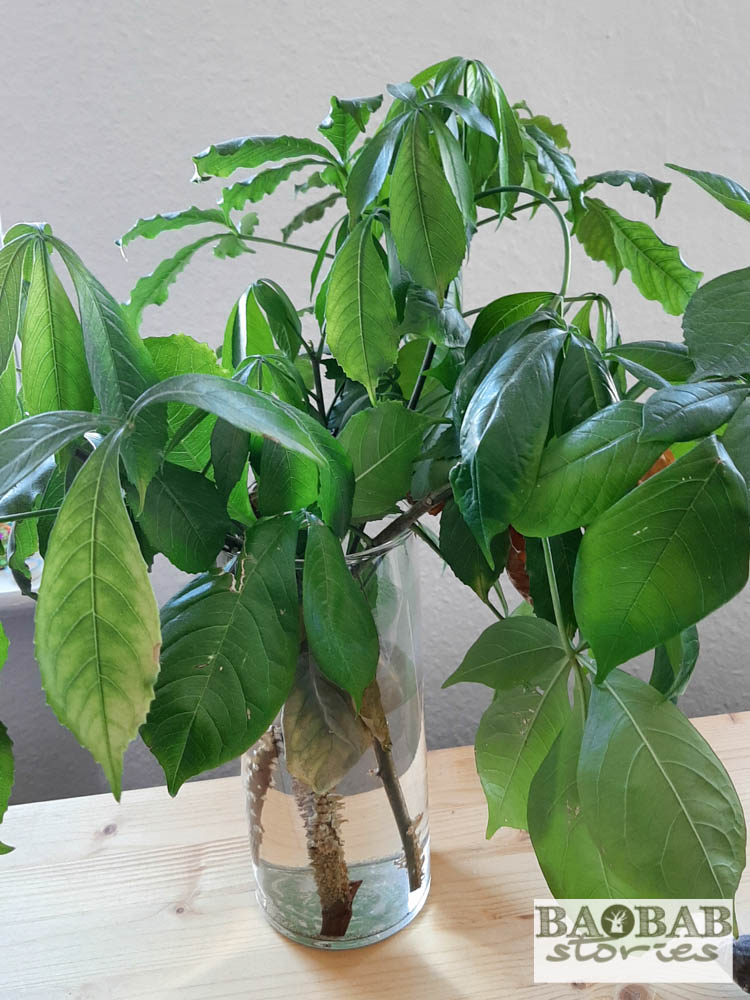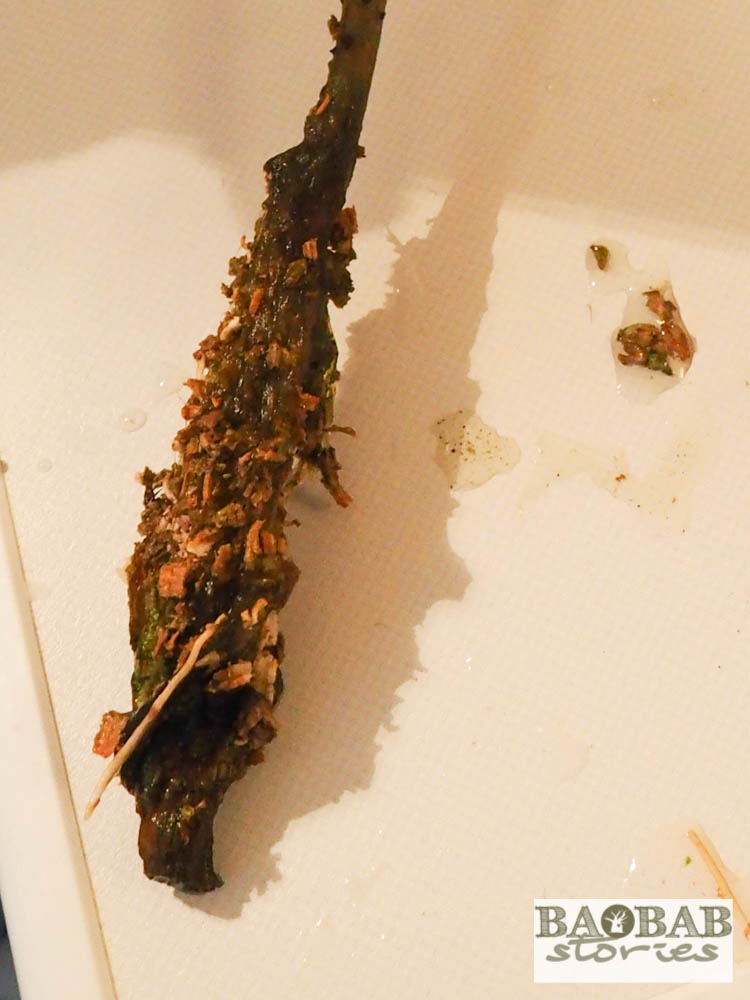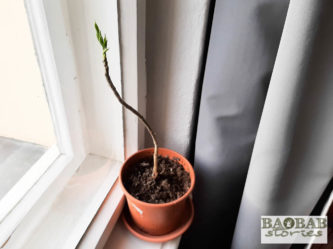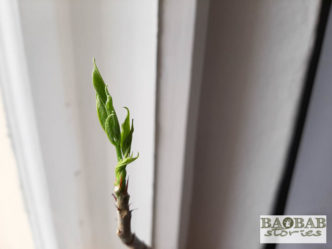Baobabs – like many other plants – propagate from a seed that is tiny for their size. This is the usual way and easy for plant lovers to germinate their own little baobab tree. But there is at least one other way to get two or even more additional baobabs from one baobab. With a little patience, baobabs can also be propagated from cut branches. You will learn how to go about it in the text that follows.

Baobab root grown on cutting from a branch
A very interesting, but unfortunately also somewhat more time-consuming way of propagating baobabs is to grow them from cut branches. A friend in South Africa who grew baobabs in a nursery for many years told me that she had propagated countless baobabs in this way. She simply cut branches from small trees, put them in containers with a mixture of water and sand and left them to themselves. In these buckets or tubs, the baobab branches quickly sprouted their roots.
My experiments in Germany were far less simple and anything but quick, but nevertheless successful. I usually propagate baobabs by cutting off the branches: Later in the summer, around mid-August, when the trees have almost finished their main growth phase, I cut off the most recent shoots. They should still have plenty of leaves, i.e. more than five to six leaves, and the stems should already show signs of lignification.
Which ist he best spot to prune baobabs?
The branch you want to use for propagating a baobab should not be too short. I make sure that it is at least 30 centimetres long – or even longer if possible. The height at which you cut depends on what you intend to do with the baobab and the cuttings. If you want to grow a bonsai from it, it is best to follow the prevailing guidelines. If you just want to have a nice little baobab with a thick trunk, you can set the height at which you cut the tree yourself. Please note: the cut on the tree will dry out a little. You should allow about two to five centimetres for this on the remaining stem. You can trim the dried-out area later. For pruning, it is best to use garden shears from a specialist shop, as you would use them for pruning roses or shrubs in the garden. Try to get a smooth cut without squeezing the stem or branch you intend to cut off.

Baobab Cuttings in container with water
Plant immediately into soil or wrap in moist cloth
Immediately place the cut branch in a container with water to prevent drying at the bottom. If this is not possible immediately, make sure that you cover the cut area with a moist piece of cloth until you can put the branch into water. For the branches I had cut and placed in a container with water and soil or sand did not work. The branches quickly started to rot and died after a short time in the water.
Pure water (rainwater or decalcified water from the tap) works better for the branches to grow roots. However, you may have to be very patient. Of the three cuttings that I had put in water in August 2019 two sprouted their first roots about a year later. The third branch is still enjoying the water. It is alive and grows new leaves and I therefore leave it as it is for now. Once it shows signs of real roots I will plant it into soil. Make sure to change the water in the container every now and then.

Baobab growing tissue resembling roots
“Roots” may only seem to be roots
Don’t be fooled by a phenomenon you may observe in the water tank: After a short time in the water, structures form on the branch that can look like roots – but are not yet real roots. If you pull the branch out of the water, they immediately collapse. If you put the branch back into the container, they will recover. By putting the branches into soil prematurely and without real roots, they may die. Real roots are white and more solid than the growth on the stems. As soon as the real roots appear you can plant the baobab branch into the soil.
The best soil for your baobab
The soil should be the same as for other baobabs: preferably cactus soil or a mixture of soil and sand. Make sure that left over water from watering or rainwater can drain away from the pot. Good drainage is essential for baobabs, as they are easily affected by root rot if they are waterlogged for too long.
Watering is done in the same way as applies with other baobabs in pots. Check with your finger whether the soil around the root feels dry. Only if it feels dry add water. Otherwise the aforementioned root rot can occur. What always fascinates me with respect to baobab roots and water: the baobab branches can cope with remaining in a water “bath” for more than a year but seem to give up and get root rot as soon as they get roots and grow in soil.

Baobab root grown on cutting from a branch
The best spot to keep your baobab
Where you keep your baobabs – the location – can make all the difference in the life of your precious trees. They like it warm, dry, bright and sunny. They do not like draughts. Baobabs that I grew from branches in 2019 were ready to be planted approximately one year later. I had put them in pots but did not have an appropriate place to put them. The air in the room was quite humid. The room needed to be ventilated several times a day. A better location was not at hand at that time. During summer, this did not proove a problem. But humidity in combination with frequent airing in winter was too cold for the little trees. The baobabs did not feel comfortable at all. Within a very short time, they dropped all their remaining leaves. The soil in the pot did not dry properly and formed white mould stains on the surface.
Fortunately I could finally place them in a room with dry air. I did not water them for a fortnight and the soil got dry. Within two weeks they recovered and – contrary to my expectations – even sprouted leaves in December last year. I consider myself lucky in two ways because when I was potting one of the branches, a large piece of the freshly sprouted root broke off. The little baobab made it anyway and did not get root rot.
Don’t be afraid to cut back the trunk of yout baobab
Growing baobabs indoors allows them to gain hight quickly – particularly if they meet the right conditions: good water supply and nutrients, a bright and sunny spot and the right temperature. The combination makes the trees shoot up almost uncannily fast. Rapid growth in height is quite normal under these circumstances. In nature, baobabs strive to grow upwards as quickly as possible during their first years. It is a means of self-protection as it allows them to escape from browsing animals. Their tender shoots and fresh leaves are popular with goats, cattle, chickens and, in the wild, antelope. As their behaviour indoors is the same as outdoors, baobabas will reach the ceiling of your home after a few years. The solution is timely pruning at the main shoot. The trees usually recover from this quite well.

Baobab cutting with a little root and growth of tissue resembling roots
Good timing of pruning kills several birds with one stone
If the pruning is well timed, you get another baobab in your collection and ensure that the plant does not “grow over your head”. Another interesting aspect: by shortening the height, the tree has more energy that it can put into growing a thick stem. With pruning the bulbous trunk shape develops quicker than without cutting it. The best time to cut back your baobab is towards the end of summer when it still has enough leaves left on the branches. The leaves help the baobab to draw water from the pot. If you cut a branch and put it into water it can continue to support its leaves. In order to keep up the support for the leaves the branch will develop roots eventually.

Baobab cutting with a little root and growth of tissue resembling roots
Propagation from branches has one drawback:
However, as far as propagating baobabs from branches is concerned, you need to take into consideration that it will take some time for those trees to develop their bulbous shape that is so typical of baobabs. The cuttings tend to grow slenderly upwards. You can try to thicken the main trunk by shortening it – but, as I said, it may take years. Nevertheless – even baobabs grown from seeds may take years to develop a baobab-like shape. Generally, it helps to grow the baobab in a smaller pot. In addition, roots and branches need to be pruned regularly to make the trunk thicken visibly. Patience is king in this case…
Baobab offshoots sprout from roots?
I came across another way of propagation on my travels. I have heard that baobabs can also form offshoots from roots in nature and reproduce in this way. I got to know an example in Kasane in Botswana. Propagation by offshoots works like this: A large, old baobab not only has a wide system of branches above the ground, but also an equally widely spreading root system below the ground. For each main branch on the tree, there is a root cord below the earth’s surface that supplies the branch above ground. In their first years of life, small baobabs draw nutrients and stored water from a taproot so that they can survive dry periods. In later years, they form a shallow root network below the soil surface, which makes them shallow rooted. In old trees, the roots can spread several hundred metres. In South Africa, there is a tree that has roots reaching up to 500 metres away.
A new offshoot, a new trunk so to speak, can sprout from these roots. The offshoot thrives at some distance from the main trunk and can develop into a large baobab itself. I got scientific confirmation of this phenomenon from researchers in South Africa focusing on baobabs in their work. In any case, this is an interesting variant of reproduction in trees and a clever survival strategy.
Baobabs – strong survivors in the wild
Baobabs, however, have even more surprises in store when it comes to the survival of the species. In various countries I have seen baobabs that were almost unrecognisable as such. In a village near Lake Malawi, the remnant of a baobab tree was “lying” – literally – on the ground. It sat there like a big grey boulder and could only be reconised as a fallen baobab at second glance. People had long since removed the branches and leaves of the former giant. The bark of the fallen giant showed signs of heavy usage. Up close, I could see that the tree was still alive. It had sprouted roots into the ground and thin branches grew from its bark – like little antennae. In the course of time and if animals and humans leave the giant alone – its branches will grow thicker and higher. Until it starts growing leaves it produces its food with chlorophyll-containing cells in its trunk. As it has stored nutrients and water, too, it may survive for quite some time and wait for better days ahead.







Hi Haike,
Thank you for the wonderful site. I followed the directions in your video and I now have three four month old Adansonia digitata growing in pots in my yard here in Phoenix – one of which is now over one foot (30cm). I am planning on raising them as Bonsai’s because while Phoenix temperature in the summer average over 38c, it can get below 7c during the winter (occasionally) so that way I can bring them in if it gets cold. A friend of mine who works for an NGO in Madagascar brought me a few Adansonia grandidieri seeds. Any special advice for germinating grandieri vs. digitata.
Dear Stephen, thank you for your positive feedback – it is well appreciated on this end & congratulations for germinating baobab seeds successfully! Good plan to plant them that you can take the baobabs indoors when it gets cold in Phoenix – they’ll appreciate it. With respect to A. grandidieri: I personally would follow the same procedure as with A. digitata – but no guarantee with it. I do have seeds of that species but have not tried to grow them yet. Sorry, but with that you’ll have to try on your own. All the best & good luck! Heike
I soak in boiled hot water for 24 hours so to make the outer skin soft …peel gently and place the inner fragile seed in a damp towel .cover and put in a dark place .it should germinate in 3 days .
Regards
Terresa South Africa +27743014103 in case you have problems germinating the seeds
Thank you very much for sharing your way of how to germinate baobab seeds successfully.
Hallo Heike – toll: Baobabs in Deutschland! It always amazes me how much valuable advice I get from German botanists / plant lovers – i need a lot of advice for my attempts to transform a small piece of stone desert into a vegetable/fruit garden in Oman. I saw that a big baobab tree in my University’s garden had loads of off-shoots all around the stem and some grew over holes in the stem. I cut off 1 offshoot with bark, 1 without.. My question is: do I plant the wooden part along with the stem? And should I not remove some of the many leaves (as I normally do with propagating from cuttings)? The baobabs in North Oman seem not to develop fruit. Never saw any, unless someone immediately harvests.
Hi Andrea, thank you for your interest in baobabs & for getting in touch. I am sorry but I do not understand your first question. What wooden part that is different from the stem are you talking about? Usually, I take the cutting and place it in water first, to give it a chance to grow new roots. That may take a while. Sometimes I take cuttings with wooden parts, sometimes I take those without wooden parts – depending on the length of the cutting and how many cuttings I would like to have.
Once the roots develop, I take the cutting and plant it into soil. In my experience, the more leaves the cutting has the better for growing new roots as the baobab needs to support the leaves and does that by giving them plenty of water – as it happens in nature during the rains. The baobab grows the leaves – apart from producing food – to be able to suck up as much water as possible because it needs to store it and it needs to support the leaves that help it to get the water into its system. Once the rains stop, the leaves fall down because they cost too much water.
Yes, it may happen that the baobabs in Oman do not produce fruit. I have heard the same from India. Some of the baobabs in Southern Africa are known as poor producers – they may have some fruit every now and then but generally do not produce fruit – contrary to those that are known as producers and carry fruit every year. Hope I could help. Kind regards and all the best to you and your baobab-project. Heike
Hello, I am growing my baobob in southern Florida in Tampa, and they are thriving beautifully. Long after I am gone even if they cut them down you have assured me that they will survive no matter what they do to them. That makes me happy. I have just cut off 2-13 inch stems and have put them in water and set them in the windowsill where they get full sun for at least eight hours a day and I’m ready to wait a year before they get some white roots. I also have stashed some seeds that I’m going to plant and start giving them to my friends and teaching them how to plant as bonsai and also all over Florida. They are absolutely magnificent trees. I want to make them indigenous to Florida. I traveled all over Africa and was awestruck at this magnificent tree and it’s dominance, tradition, and longevity. Thank you so much for the information. Diana Wilson PhD
Hi Diana, thank you so much for your comments & appreciation of my website – it is highly appreciated on this site. All the best to you and your Florida-Baobab-Project, it sounds exciting. Please keep in touch and let me know how it develops. All the best to you and your baobabs – Kind regards, Heike
I am propagating baobabs from seeds brought from Senegal and experimenting with tall, skinny houseplant and bonsai versions in Kansas City. I am in year 2 for my first and year 1 for the second. They both share a shallow “trainer” pot, presently. Your one picture above of a naked stem with little leaf buds on top was comforting, as I worry every year that they won’t “come back.” My concern is this: My little saplings aren’t growing any branches, not for a bushy tree-plant and not to make cutting. They just keep shooting taller and taller. How can I prune them short to thicken the “trunk” into a bonsai if the leaves are always at the tip-top? Any ideas?
Hi Gina, thank you for getting in touch & I know about the challenge. What helped me was to drastically cut the main stem to the height I wanted it. During the first attempts it continued as you described – it sprouted one stem. After several times of cutting the tree down it finally sprouted several branches at once this year. The behaviour is quite normal for baobabs as they try to gain in height as quickly as possible during their first years. This helps them to outgrow animals that like feeding on the little saplings & leaves. The effect is their survival in the wild. Hope that helps. Good luck & kind regards, Heike
I have a baobab that is way too tall for a bonsai. Most of my bonsai friends advise air layering but I don’t know if there is any special consideration for this. It seems that soaking the sphagnum moss with water would promote root rot in the new roots.
if I chop it off now, June in the northern hemisphere, would you expect it to sprout new limbs on the bottom part? Could I put the top in water and expect it to grow roots?
Hi Ivan, thank you for getting in touch re your Baobab/bonsai project. I have not tried to produce saplings on baobabs by air layering – therefore I cannot advise on this. Regarding root rot: it depends how long the roots remain in contact with the water – particularly once the plant grows in soil. Maybe it works different if the roots are in contact with the moss? Regarding cutting back the baobab – you can do that year round. The hottest monthes are yet to come – so there is a good chance that the baobab sprouts new branches around the area where you cut it back. But there is no guarantee! The same refers to putting the cut branches in water. Experience tells me that some grow roots, some do not – therefore, there is no guarantee that the cuttings grow roots. Hope this helps in your decision making – Kind regards, Heike
Hello from London and thank you for your very detailed site.
I have been given a small baobab from Senegal that has been sold for potting up – it looks like a 15cm long stick with some roots at the thicker end but is all dried out. I still want to try to grow it and wonder if I should start by putting in water or in a free draining soil?
What would you advise?
Hi Kelly, thank you for getting in touch and for your interest in growing a baobab “stick”. Is the bottom of the stick covered with a fine layer of wax? If so, you’d have to remove it. Then I recommend that you put the stick in warm (NOT boiling) water and leave it for a few days. If it is still ok it should start producing roots (look like tiny white shoots). I am afraid it is the wrong time of the year to start with a baobab project as the trees outside are about to drop their leaves and so do my baobabs on the window sill (at least they will start soon). Hope this helps and good luck! Kind regards, Heike
Isn’t it better by seed so that they develop a taproot?
BTW I have not seen the information about the Minimum depth of soil needed to plant them so that they develop at their best. do you know this?
I am also curious about how fast they grow and according to which parameters.
I live in the Canaries, largely frost free, but our summers are not often hot thanks to the ocean nearby. so I wonder how tall they can become in 5 and 10 years after planting for example.
Thanks for any new information about this!
Hello Xisca Nicolas,thank you for getting in touch. Yes, it ist better that the trees have enough space to develop a taproot. If you read the steps in this blog post you’ll find the information: https://baobabstories.com/en/baobab-seeds-how-they-germinate-easily/
Hope, that helps. During the first months and years they grow fast. Here is another link to a three year old tree: https://baobabstories.com/en/aarons-baobab-secret/
Kind regards, Heike
Great tips on propagating baobabs! It’s fascinating how a plant so large can be started from something as small as a branch. With a bit of patience and the right care, it’s amazing how many new baobab trees you can grow. I’m sure plant lovers will appreciate the insight on this alternative method of propagation. It’s always rewarding to grow your own tree, and learning new techniques like this can make it even more fulfilling! Thanks for sharing!
You are very much welcome Elliot Read, thank you for your appreciation & feedback. Kind regards, Heike